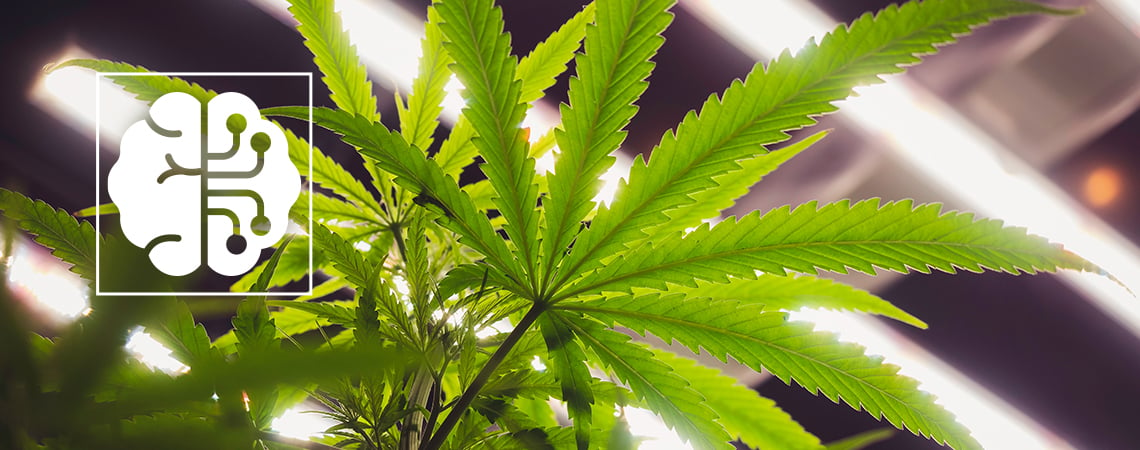
How AI and Automation are revolutionising the Cannabis Industry
AI is reshaping the cannabis industry—from smart grow ops to automated packaging and tailored retail experiences. Here’s how this cutting-edge tech promises to drive efficiency, quality, and growth in the world of weed.
Few industries are unscathed by the rise of AI. And cannabis is no different. While the world’s strange, outdated, and sometimes contradictory cannabis laws can leave weed businesses operating on unstable ground, that hasn’t stopped them from seeking out the rewards of incorporating AI into their operations.
But what does AI in the cannabis industry look like? Well, it goes far beyond automated sprinkler systems. AI solutions promise to revolutionise the industry by streamlining processes from the cultivation stage all the way through to the retail experience. In this article, we’ll shine a light on some of the innovative ways in which AI and related technology promises to change the weed world forever.
What does AI have to offer the cannabis industry?

The cannabis industry shows a lot of promise. According to Fortune Business Insights (2025), it’s worth will top USD 444 billion by 2030. And while it’s still in its infancy, the legal weed business primarily centres around three core processes.
First (and probably most obvious) is the agricultural aspect—we shouldn’t forget that weed might just be mankind’s oldest crop. This encompasses everything from sowing seeds up until harvesting cannabis flowers.
After that comes production (which involves trimming, drying, and packaging cannabis) and manufacturing (e.g. processing natural or “raw” cannabis into edibles, extracts, and topicals).
And finally, we have retail—the sale of cannabis products to consumers.
Of course, the legal weed industry encompasses other areas, like tourism. But for the purpose of this article on cannabis and AI, we’ll focus mainly on how automation, AI, and robotics affect the cultivation and processing of cannabis, as well as the retail experience of buying it. In doing so, understanding the effect of smart technologies in the cannabis industry as a whole becomes a lot more straightforward.
The role of AI in cannabis cultivation and agriculture
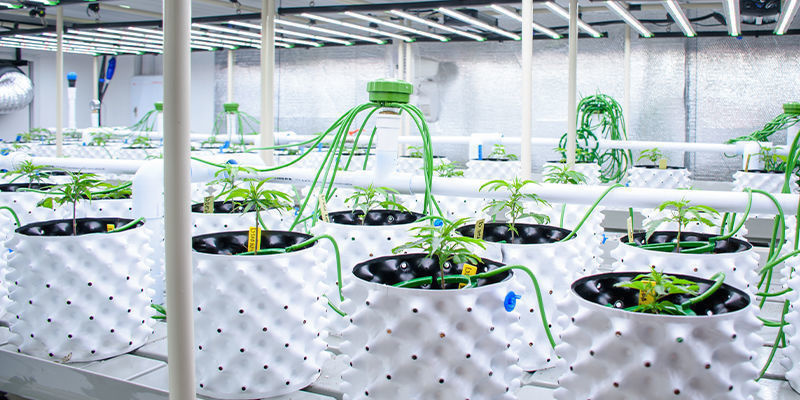
Cannabis, like any other crop, relies on good growing conditions to produce the highest-quality end product and profitable yields. And with the power of AI, providing cannabis plants with perfect growing conditions can become a fully autonomous endeavour.
Simple examples of automated grow equipment you may already be using include AC units, dehumidifiers, and humidifiers with built-in sensors that allow the machines to turn on and off autonomously as needed. Keep climbing the ranks of the automation ladder, however, and you’ll find fully automated grow systems that can handle literally every aspect of cultivation, including:
- Climate control (temperature, humidity, and ventilation)
- Feeding and irrigation
- Soil health (pH, EC, humidity, and nutrient balance)
Hey abby (n.d.) and LEAF (n.d.), for example, both manufacture fully automated grow boxes targeted at home cultivators. Equipped with hydroponic systems supported by modern AI algorithms, these tools handle everything from temperature and humidity control to feeding and pH balancing.
Rather than spending hours hunched over in a tent checking on your plants, systems like Hey abby and LEAF allow you to track the conditions in your grow room and all other aspects of your operation from your smartphone via their respective apps.
More elaborate examples of AI technology in cannabis cultivation include automated greenhouses, which aren’t unique to the world of growing weed, either. Companies like AutoGrow (n.d.), for example, have developed automated greenhouses and indoor rooms equipped with the technology to control every aspect of cultivation.
AutoGrow’s systems also feature all the software needed to track and monitor the most important grow data. MyAutoGrow, for example, is a cloud-based system that promises to allow growers to not only view but also adjust their grow from anywhere in the world.
The benefits that come with this kind of automation are monumental. They include:
- Lower operating costs: Allowing technology to control grow processes frees up time and resources.
- Easier tracking: When processes become more streamlined, they’re also easier to track and manage. This can facilitate meeting compliance standards, as well as logistics.
- Increased efficiency: With access to precise, ever-evolving data, growers can spot exactly which areas of their operation to improve, and how.
- Better consistency: Automated grow rooms and the data they provide take the guesswork out of growing and minimise human error, making it easier to spot and repeat processes that have been proven to work.
- Real-time information: Cloud portals like MyAutoGrow mean growers can see changes in their operation as they occur and act accordingly.
- Higher yields: By making it easier to give plants the best growing conditions, heavier harvests become the norm.
AI in cannabis pest control
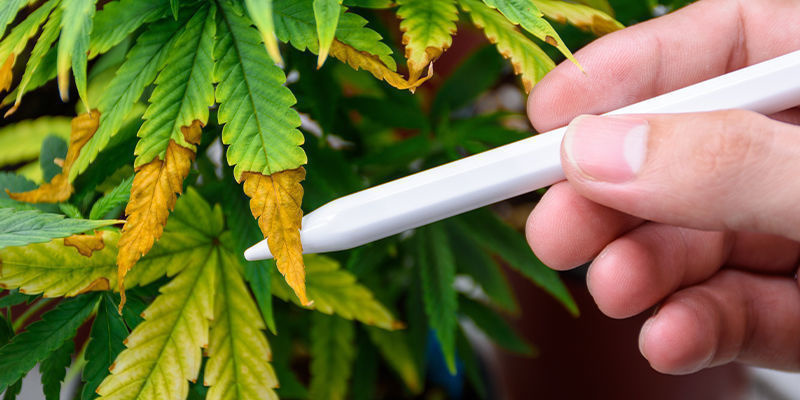
Pests are a huge concern for the agricultural sector, including in cannabis cultivation. According to the UN Food and Agriculture Organization, up to 40% of human crops are lost to pests everywhere, causing billions in economic losses (Food and Agriculture Organization of the United Nations, n. d.).
Traditionally, dealing with cannabis pests and pathogens has been an arduous process. First of all, growers have to be able to spot and identify pests quickly, which can be challenging, especially in large operations and given that different pests can produce similar symptoms.
Then, actually combatting cannabis pests is also challenging. While there’s no shortage of pesticides out there, using these chemicals on a product that’s designed to be heated and inhaled raises a lot of health concerns. Moreover, the use of pesticides (even natural ones) can strongly interfere with the unique aromas and flavours of weed. Luckily, AI also shows a lot of promise in changing the way growers combat weed pests.
In 2022, Slovenian company Trapview launched an AI-powered bot that can track, trap, and identify pests simultaneously (Picheta, 2022). The device first uses pheromones to attract pests, then traps them. Finally, using computed vision and data from the world’s biggest visual insect database, Trapview can identify insects and log exactly where they were caught and other details (like local temperatures). Trapview can also map out the impact a pest infestation could have on the coming harvest. In some cases, Trapview can also provide suggestions on what pesticides to use to follow up an encounter with a pest.
Another example of AI pest control is Semios—a self-dubbed “precision farming platform” that uses Google Earth, BigQuery, and IoT sensors to detect pests and environmental changes in fields (Google Cloud, n. d.). Not only does Semios deliver all of that info to farmers, but it can also use it to make predictions about crop threats—including pests and even harsh weather.
Finally, Plantix uses AI not to detect pests but instead properly diagnose unhealthy plants (PEAT GmbH, n.d.). Besides pests, common disturbances to the growth of cannabis plants include environmental stressors such as light stress, light burn, or nutrient imbalances—all of which can produce similar symptoms that are notoriously difficult for growers to tell apart. Plantix, however, takes the guesswork out of identifying plant symptoms. Using the camera on your smartphone, it can scan the damage on your plant and run it through an ever-growing database to come up with a diagnosis and treatment plan to match.
AI in cannabis strain development
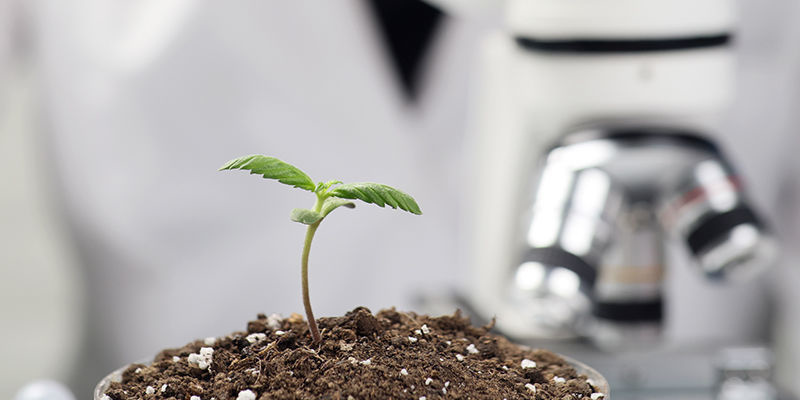
Genetics are one of the biggest drivers of cannabis sales. For growers, a good genetic base promises the right growth traits for a specific environment and heavy yields. Meanwhile, for end consumers, the perfect strain is all about blending the right effects, aromas, and flavours. Now, AI might be able to take care of at least part of the breeding process. Some of the ways in which AI might help breed new cannabis varieties include:
- By providing data on strain relationships: AI databases can offer breeders continuously updated information about the genetic relationships between different strains. An early example of this was the Phylos Galaxy (Wallace, 2019), which was designed to provide a roadmap to breeders, allowing them to see the genetic similarities and differences of potentially thousands of strains from across the globe.
- By picking what strains to cross: In 2022 and 2023, Israel’s Canonic Ltd. (a subsidiary of Evogene Ltd.) brought to market eight cannabis hybrids bred using AI (Canonic, 2023). The company used an AI engine called GeneRator to select strains for crossbreeding based on their THC concentration and terpene profiles. Similar technologies could be used to suggest which strains to cross based on their resilience to specific pests or environmental conditions, growth traits, and more.
- By fast-tracking pheno hunts: Just like AI technology can be used to monitor plants for pests, pathogens, or nutrient deficiencies, it can also be used to monitor them for desirable characteristics such as stature, flowering time, appearance, resin production, flower structure, and vigour. This has the potential to reduce the intense labour that traditionally characterises a cannabis pheno hunt.
- By analysing consumer preferences: Like in other industries, cannabis consumers dictate market trends in terms of strain flavours, aromas, and potency. Breeders could potentially stay on top of these trends by using AI models to analyse market trends and suggest breeding programmes to produce strains with traits to match. In fact, predictive AI models could even help companies anticipate certain trends in consumer preferences and meet them early for a competitive advantage.
Automation and AI in cannabis production

According to CEO of Leafy Pack Alain Vo (2024), the cannabis industry is still heavily reliant on manual packaging. However, that promises to change as companies roll out new machines leveraging AI and robotics to streamline post-harvest processes like trimming, sorting, and packing.
Some examples of companies and services implementing these innovations include:
- Mobius Trimmer (Mobius, n.d.): Based in British Columbia, Mobius has developed a line of automated cannabis harvesting machines, including trimmers, buckers (which remove flowers and leaves from plants), sorters, and mills. This type of machinery reduces the manpower needed to harvest weed, bringing the cannabis industry up-to-speed with the kinds of tools you’d find in other agricultural sectors.
- Marvel by Twister Technologies (n.d.): Marvel is a cannabis-grading machine that inspects, grades, and sorts cannabis at a rate equivalent to that of 10 people. It also learns and compiles data from every flower it sorts. As if that weren’t enough, Marvel can build elaborate batch reports and visual analyses of each flower, allowing growers to get a more accurate picture of the quality of their harvest.
- Paxiom (Paxiom Group, n.d.): Cannabis companies typically need to meet strict packaging guidelines. Paxiom has produced a whole line of machines designed to seamlessly package everything from flower to edibles and concentrates, all to the strict standards governing the industry. Jar-fillers, form-fill-sealers, and pre-roll machines are just some examples of the machinery slowly being rolled out to help cannabis businesses streamline their packaging processes.
Adopting machinery and systems like these promotes a streamlined and efficient post-harvest procedure, as well as consistent product quality. Through the use of AI and robotics, cannabis companies can add precision to their post-harvest procedures while minimising human error and relocating human resources to more complex roles—all while cutting costs, too.
AI learning systems like those integrated into machines like Marvel gather data throughout the entire production process, providing insights that can be used to optimise a company’s operations in the future. Finally, the tools mentioned above also promote faster production processes and increased scalability.
AI in the manufacturing of cannabis derivatives (such as concentrates and edibles)
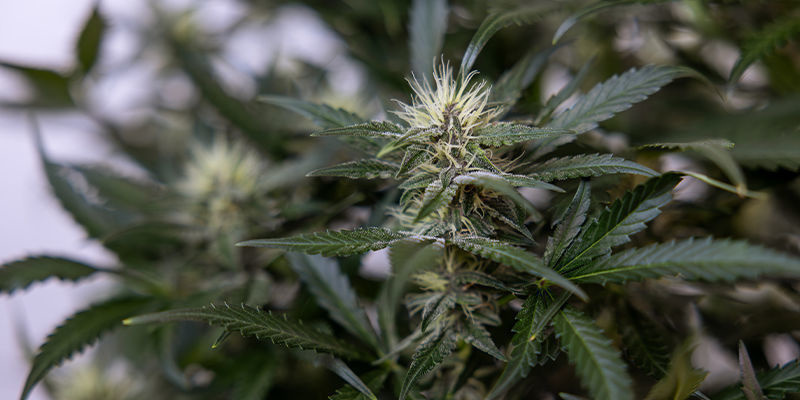
Another area where AI has a lot of potential is in the manufacturing of cannabis-derived products, including (but not limited to) edibles, concentrates, and extracts. Examples of this include:
- Quality control: One of the most significant challenges in manufacturing cannabis products is ensuring product consistency. AI-powered systems can test large batches of product for cannabinoid levels or terpene profiles and compare them to vast data sets, helping manufacturers meet the mark more consistently. Moreover, AI analytics software can be used to rapidly scan products for visual defects or contaminants, minimising the risk of sub-par products reaching the shelves. AI can also help analyse trends in the production of cannabis products and draw a manufacturer's attention to the processes that consistently produce good results, as well as those that don't.
- Formula predictions and testing: AI systems can be used to produce recipes for edibles or extracts with specific traits, such as a particular potency, texture, aroma/flavour, or effect.
Enhancing cannabis retail with AI
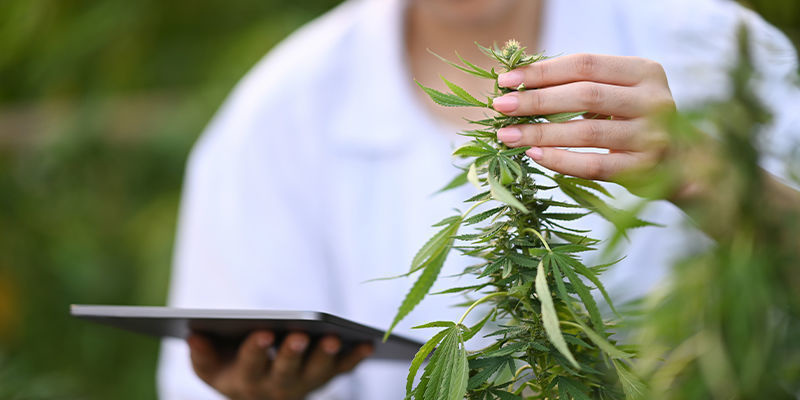
Artificial Intelligence isn’t just revolutionising the way cannabis is grown and manufactured—it’s also increasingly transforming the cannabis retail landscape. AI algorithms and tech solutions can offer innovative ways to enhance customer experiences and optimise retail operations.
In doing so, AI retail solutions help cannabis retailers serve their customers more efficiently, deeply analyse their sales data, and even enhance the security at their points of sale. This results in a streamlined buying experience, increased customer satisfaction, and heightened profits.
Some notable applications of AI in cannabis retail include the following.
Personalised product recommendations
AI algorithms can analyse customer data, such as their purchase history and preferences, to provide them with tailored product suggestions, which promises an enhanced consumer experience and, ultimately, increased sales potential.
StrainBrain, for example, is a tool designed to help both experienced and new cannabis users avoid getting lost in the sea of products available to them (Sacirbey, 2021). The way it works is simple—users fill out a survey while at the dispensary, providing information about the effects, aromas, and flavours they’re seeking. It then presents customers with a list of products in the inventory that match those preferences. It’s also particularly handy for customers shopping online who don’t have a physical budtender to talk to and consult for recommendations.
Spark Pro, on the other hand, is a similar AI-driven tool but targeted at budtenders (Jointly, 2024). Using information from Jointly, a mobile app where users can browse and buy cannabis products after selecting specific uses and preferences, Spark Pro provides budtenders with constantly updated, user-driven information on thousands of products—ultimately helping them guide their customers towards the right strains and products.
Inventory management and demand forecasting
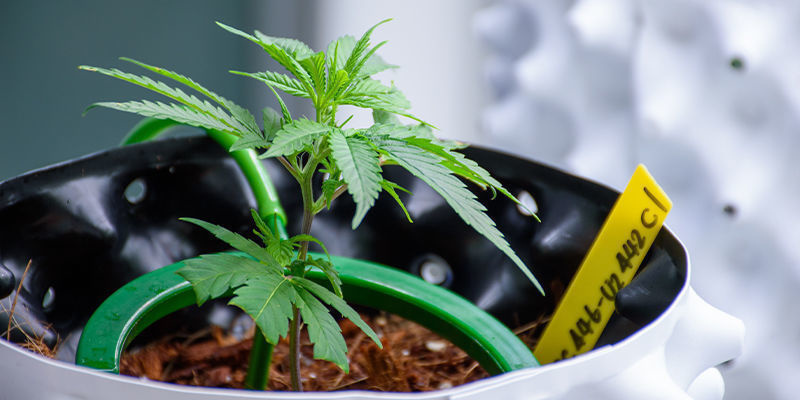
AI can not only streamline the retail process for cannabis customers—it can also help retailers better manage their inventory and offer an improved sales experience by analysing POS data.
Headset, for example, is a Seattle-based company offering a SaaS suite tailored to the needs of cannabis companies (Headset, n.d.). Its Retailer software, for example, can not only measure the sales performance of different products but also provide actionable steps on how to adapt your inventory accordingly. This helps prevent shortages of popular stock and minimises the risk of overstocking less-popular products. Headset’s Retailer can also help predict customer behaviour and help retailers ensure they stay ahead of sales trends.
Improved customer service and engagement through AI-powered chatbots

Chatbots might not be the most beloved or exciting face of AI technology. However, they can have a big impact on the cannabis retail experience when employed properly. Well-trained AI chatbots do a good job of resolving basic customer enquiries regarding product availability, the effects of different products, and guidelines regarding how to use or dose a product.
Their immediacy and round-the-clock operation make them an ideal first line of defence in the retail sector, freeing up human customer service staff to tackle more pressing matters. Some examples of AI chatbots tailored to the needs of cannabis companies include:
- BakedBot’s Smokey (BakedBot.ai, n.d.)
- Pluggi, powered by BudtenderGPT (Pluggi, n.d.)
- Spark Budtender (n.d.)
Enhanced security and compliance

AI video analytics can help cannabis retailers ramp up their security measures, detecting suspicious behaviour as well as monitoring and analysing customer traffic patterns. This can greatly improve security at retail stores like dispensaries. In some parts of the world, cannabis retailers are still heavily reliant on cash payments due to banking restrictions, making security a top priority.
Moreover, AI video analytics can also help cannabis companies meet compliance requisites. For example, they can monitor employee behaviour and actions, and immediately report any failures to meet safety protocols. Companies that offer AI video-monitoring solutions for security and compliance purposes include:
- Arcadian AI (n.d.)
- Solink (n.d.)
- March Networks (n.d.)
Compliance is a huge buzzword in the world of legal weed, and cannabis companies need to be well aware of their legal obligations and restrictions. However, cannabis laws can vary greatly from one district to another and can change with little notice. For cannabis companies, this makes it challenging to ensure they’re always acting above board—especially if they operate across different geographical areas or branches of cannabis production.
AI solutions can address this issue by offering up-to-date, cited compliance information. CannabisRegulations.ai (n.d.), for example, relies on natural language processing and machine learning to automate regulatory updates and help companies adhere to local laws—even across various US states.
Challenges of implementing AI and automation

So far, we’ve covered detailed examples of how AI can help streamline the processes behind the cultivation, production, manufacturing, and sale of legal cannabis. Unfortunately, however, the road to implementing some of these technologies in the cannabis sector is fraught with challenges.
Below are some of the biggest hurdles cannabis companies face when implementing AI and automation.
Regulatory uncertainty and compliance complexities

One of the most significant barriers to adopting AI and automation in the cannabis industry is the ever-changing regulatory landscape. Laws governing cannabis cultivation, processing, distribution, and sales vary widely across jurisdictions and change often. Implementing AI systems that comply with these regulations can be tricky.
High initial investment costs
AI and automation technologies typically require significant upfront investment. Cannabis businesses, especially smaller operators, may struggle to justify or secure the capital needed for these advanced systems. From purchasing specialised equipment to hiring technical experts or consultants to facilitate the process of acquiring this technology, costs quickly add up.
Workforce resistance and skills gap

The integration of AI and automation often encounters resistance from employees who fear job displacement. In the cannabis industry, which has traditionally relied on manual labour for cultivation, harvesting, and processing, this resistance might be particularly pronounced.
At the same time, because AI is so novel and rapidly evolving, cannabis companies may struggle to find staff with the skill set to properly take advantage of some of the technologies mentioned in this article.
Data privacy and cybersecurity concerns
AI systems in the cannabis industry often rely on large volumes of data, including customer information, cultivation metrics, and supply chain details. The sensitive nature of this data makes companies vulnerable to cyberattacks and breaches. Implementing robust cybersecurity measures alongside AI and automation systems adds another layer of complexity and cost. As companies plan to take advantage of this data, they are also faced with the challenges surrounding ethical data handling.
Environmental impact and sustainability

While automation can improve resource efficiency in cannabis cultivation, the technology itself may have an environmental footprint. High-tech systems like automated lighting, climate controls, and AI-driven grow systems can consume significant energy—something that’s already a concern in the cannabis industry, which receives plenty of scrutiny for its environmental footprint (Clark Hill, 2022).
Rapid technological advances
The pace of innovation in AI and automation is relentless. Cannabis businesses that invest in current technologies risk facing obsolescence within a few years as newer, more advanced systems emerge. This short life cycle makes it challenging for companies to achieve a satisfactory return on investment, and can deter businesses from adopting these technologies in the first place.
Future implications of AI for the cannabis industry
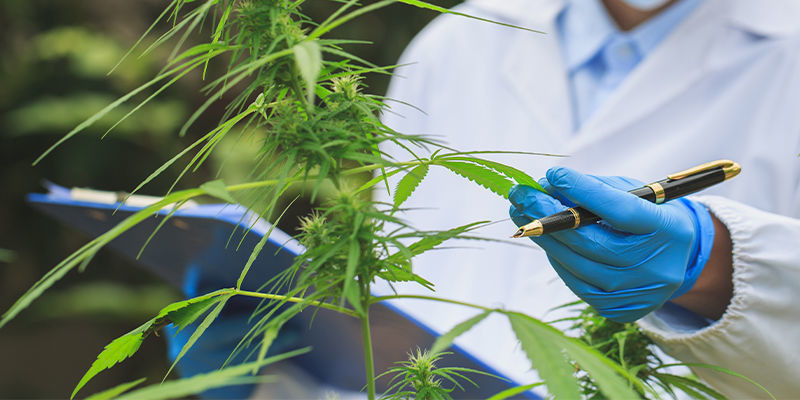
The rise of AI technology promises to streamline the cannabis industry further, particularly in the areas of cultivation, production/manufacturing, and retail. Companies able to leverage AI technology in these sectors stand to free up human resources, offer higher and more consistent product quality, and access to better, more insightful data.
However, adopting AI and automation in the weed industry doesn’t come without its challenges. High costs, rapid technological investments, and an ever-changing legal landscape make it difficult for cannabis companies (especially small ones) to really dig their claws into these new technologies.
Nonetheless, one thing is certain—AI is already making a huge mark on cannabis industry processes, and will only continue to do so in the future. Those companies lucky enough to leverage this tool will undoubtedly have a serious advantage as the market continues to grow and become more competitive.
- Autogrow. (n.d.). (January 24, 2025). Ag-Insights, Greenhouse Crop Data Management Dashboard — Autogrow - https://autogrow.com
- BakedBot AI. (n.d.). (January 24, 2025). BakedBot AI – Cannabis AI Agents - https://bakedbot.ai
- CannabisRegulations.ai. (n.d.). (January 24, 2025). Simplify Cannabis Compliance with AI | CannabisRegulations.ai - https://www.cannabisregulations.ai
- Canonic. (2023, February 21). Canonic Successfully Launched Six Second-Generation Cannabis Products with Higher THC and Rich Terpene Profiles - https://www.prnewswire.com
- Clark Hill. (2022, April 14). Cannabis and the environment: Seven significant side-effects - https://www.clarkhill.com
- Food and Agriculture Organization of the United Nations. (January 24, 2025). About | Plant Production and Protection | Food and Agriculture Organization of the United Nations - https://www.fao.org
- Fortune Business Insights. (2025, January 6). Cannabis Market Size & Growth | Forecast Report [2030] - https://www.fortunebusinessinsights.com
- Google Cloud. (n.d.). (Helping growers produce more sus). Semios Case Study | Google Cloud - https://cloud.google.com
- Headset. (n.d.). (January 24, 2025). Business Intelligence for Cannabis Retailers | Headset - https://www.headset.io
- Hey abby. (n.d.). (January 24, 2025). Hey abby Automated Grow Box Kits | Indoor Hydroponics Growing System - https://heyabby.com
- Jointly. (2024, July 10). Introducing Budtender Superintelligence: by Jointly - https://www.cannabisbusinesstimes.com
- LEAF. (n.d.). (January 24, 2025). Automated hydroponic home grow system - https://www.getleaf.co
- March Networks. (n.d.). (January 24, 2025). Intelligent IP Video Surveillance — March Networks, Home - https://www.marchnetworks.com
- Mobius Trimmer. (n.d.). (January 24, 2025). Cannabis Trimming Machine & Post Harvest Equipment | Mobius - https://mobiustrimmer.com
- Paxiom Group. (n.d.). (January 24, 2025). Cannabis Packaging Machine Automation - https://www.paxiom.com
- PEAT GmbH (n.d.). (n.d.). Plantix | #1 FREE app for crop diagnosis and treatments - https://plantix.net
- Picheta, & R. . (2022, November 24). Can an AI-powered insect trap solve a $220 billion pest problem? | CNN Business - https://edition.cnn.com
- Pluggi. (n.d.). (January 24, 2025). Meet Pluggi, Budtender AI Agents for Dispensaries - https://www.meetpluggi.com
- Sacirbey, & O. (2021, September 1). StrainBrain uses technology to recommend cannabis products based on customer preferences, inventory. - https://mjbizdaily.com
- Solink. (n.d.). (January 24, 2025). Cloud Video Surveillance for Business Security | Solink - https://solink.com
- Spark Budtender. (n.d.). (January 24, 2025). Virtual Budtender Chatbot for Cannabis Dispensaries | Spark Budtender - https://sparkbudtender.com
- Twister Technologies. (n.d.). (January 24, 2025). Marvel AI - Deep Learning Cannabis Sorter, Grading, Quality Assurance - https://www.twistertrimmer.com
- Vo, & A. (2024, July 29). Automation is Streamlining Cannabis Packaging - Packaging Technology Today - https://www.packagingtechtoday.com









 United States
United States








